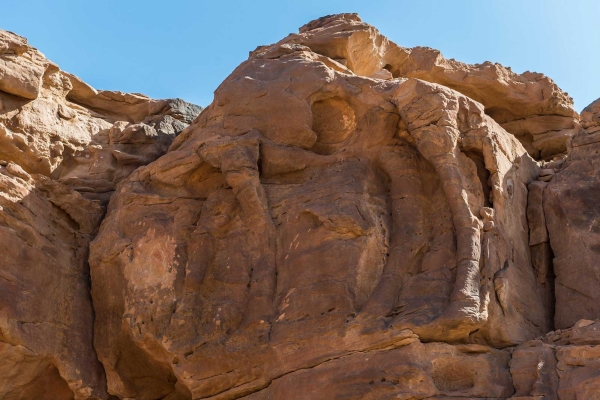
The Camel Carving Site is an archaeological site of prominent rock drawings, located on the facade of a mountain in the city of Sikaka, the administrative capital of al-Jawf Province in the north of the Kingdom of Saudi Arabia. The site was discovered by a joint Saudi-French scientific team in 2016.
Inscriptions and history of the Camel Carving Site
The Camel Carving Site encompasses rock carvings of camels. The inscriptions date back to more than 5,200 years BC, and the site is one of the distinguished rock art sites in the Arabian Peninsula.
There are several carved figures on the site, including: a sculpture of an Arabian camel raising its head and resting on its feet, a sculpture depicting a female camel with two young camels, one preceding her and the other following her, and another sculpture depicting a camel and a donkey.
The Camel Carving Site dates back to the Neolithic Age, between 5,200 and 5,600 years BC, according to studies published by the Journal of Archaeological Science, undertaken by a joint Saudi-international team of researchers from King Saud University, the Heritage Commission, Max Planck Institute, in addition to the French Research Institute, the University of Oxford, the Free University of Berlin, and others.
Results of scientific studies on the Camel Carving Site
Scientific studies on the site indicate that it encompasses twenty-one carvings, including: an unidentified carving, two carvings from the Equidae family, and seventeen carvings of camels. Moreover, evidence indicates that the carved shapes have been preserved, or that work was being executed to carve new pieces as a substitution for damaged parts, due to erosion factors over time. The study suggests that the site may be one of the oldest sites in the world for carving life-size animals.
Archaeological objects excavated at the Camel Carving Site indicate the presence of animal bone remains and distinctive stone carving skills. Studies have suggested that the stone craftsmanship discovered at the site dates back to the end of the Neolithic period, with techniques for carving life-size animals varying over different time periods.
Chronological stages at the Camel Carving Site
The Camel Carving Site underwent three chronological periods: First, the implementation of the sculpture works over a long period of time; second, a period characterized by an absence of human activity and abandonment of the site; and finally, the carved objects began to deteriorate due to natural factors, with some parts falling off.
Related quizzes
Related articles

